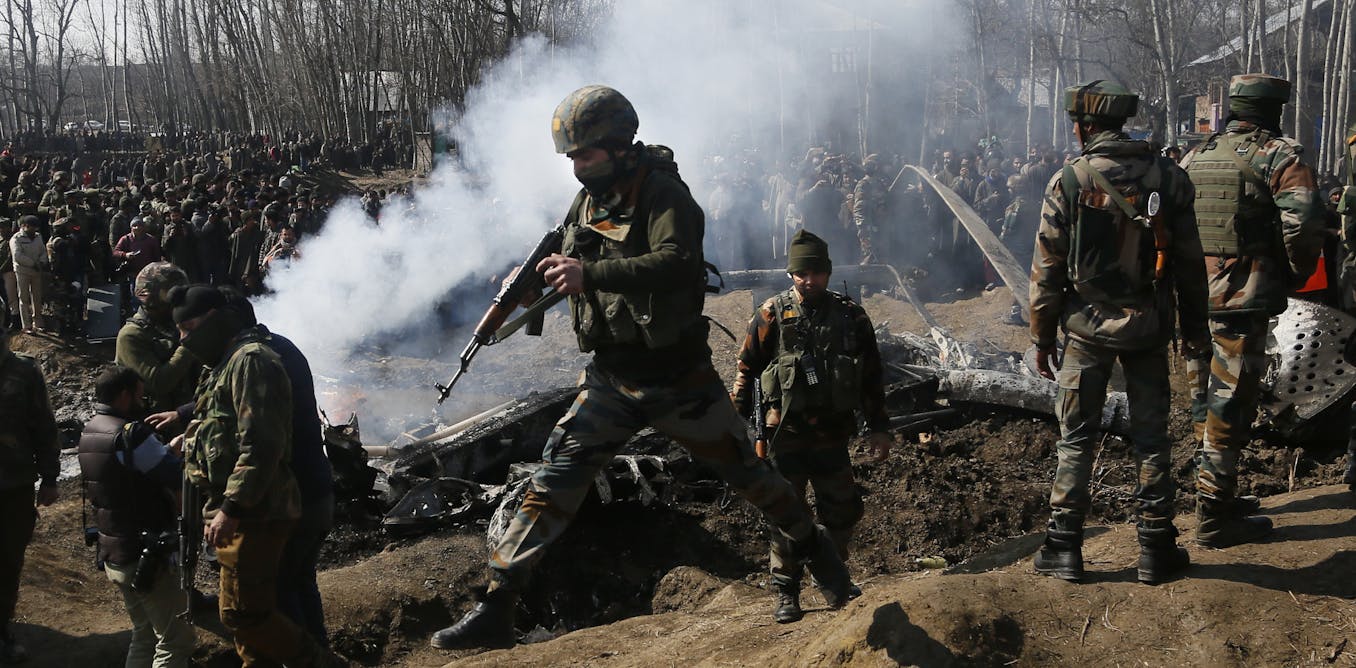Kashmir Dispute: How It All Began in the heart of the Himalayas lies a land of breathtaking beauty and spiritual depth—Kashmir. For centuries, it flourished as a cultural crossroads, attracting poets, mystics, and merchants. But beneath the majestic mountains and pristine lakes lies a bitter tale of political strife. The origins of Kashmir dispute are entangled in the historical, religious, and geopolitical upheavals of South Asia’s most turbulent century.

A Jewel in the Crown of the Subcontinent
Kashmir’s legacy predates modern borders. As early as the Mauryan era, it was a cradle of Hinduism and later embraced Buddhism under Emperor Ashoka. In the 14th century, Islam arrived, further enriching the region’s spiritual mosaic. Kashmir became renowned for its Sufi traditions, where diverse faiths coexisted in harmony.
By the 19th century, following a series of invasions and power shifts, the region fell into the hands of the Dogra dynasty. Maharaja Gulab Singh purchased Kashmir from the British East India Company under the Treaty of Amritsar in 1846. Thus, Kashmir became a princely state under the British Raj but ruled by a Hindu monarch over a largely Muslim population.
This demographic dichotomy would later become a decisive fault line. The origins of Kashmir dispute lie in this intersection of faith, identity, and imperial inheritance.
The Partition of 1947: A Continental Schism
The turning point came in 1947, when British India was partitioned into two sovereign nations: India and Pakistan. The subcontinent bled through the largest human migration in history, with millions uprooted and over a million killed in communal massacres.
The princely states, over 560 of them, were given a choice—join India, Pakistan, or remain independent. For most, the decision was simple. But not for Kashmir. Its ruler, Maharaja Hari Singh, was caught in a perilous dilemma. He was Hindu. His subjects, predominantly Muslim. His territory—strategically vital and mountainous—shared borders with both newly-formed nations.
Initially, Hari Singh chose neither. He aspired to independence. But this vacuum of decision would not last long. The origins of Kashmir dispute exploded into reality in October 1947.
The Tribal Invasion and Instrument of Accession
As Pakistan gained independence, it believed that Kashmir, due to its Muslim majority, should rightfully accede to it. Frustrated by Hari Singh’s indecision, Pakistani tribal militias—allegedly with state backing—invaded Kashmir, aiming to wrest control.
Faced with an existential crisis, the Maharaja turned to India for military assistance. India agreed—on the condition that Kashmir formally accede to the Indian Union. On October 26, 1947, the Instrument of Accession was signed. Indian troops were airlifted into Srinagar the next day, repelling the tribal incursion.
This marked the moment when the origins of Kashmir dispute turned into a full-blown war between India and Pakistan. The First Indo-Pak War had begun.
The United Nations Steps In
As fighting intensified, India took the matter to the United Nations in January 1948. The UN recommended a ceasefire, the withdrawal of Pakistani forces, and a plebiscite to let Kashmiris decide their future. But the conditions for the plebiscite were never met.
The ceasefire, enforced on January 1, 1949, resulted in a divided Kashmir. Pakistan retained control of the northern and western regions (now known as Azad Jammu and Kashmir and Gilgit-Baltistan), while India held the Valley of Kashmir, Jammu, and Ladakh.
The Line of Control (LoC) became the new, though unofficial, boundary. The UN had prevented further bloodshed, but the origins of Kashmir dispute remained unresolved. Each side blamed the other for violating the preconditions for a plebiscite.
Two Nations, Diverging Narratives
Over the decades, India and Pakistan developed conflicting narratives about Kashmir’s accession.
India insists that the Instrument of Accession was legal and final. It argues that, like other princely states, Kashmir’s ruler had the sovereign right to choose his nation. Moreover, India claims that the democratic aspirations of Kashmiris are reflected through regular elections and constitutional inclusion.
Pakistan, on the other hand, maintains that the accession was obtained under duress and that the promised plebiscite was never conducted. For Pakistan, the origins of Kashmir dispute are rooted in an unfinished agenda of the 1947 partition—the idea that Muslim-majority regions should form part of Pakistan.
These contrasting positions calcified over time, hardening public opinion and diplomatic stalemates.
The 1965 and 1971 Wars: Reigniting the Conflict
In 1965, Pakistan launched Operation Gibraltar, sending insurgents into Indian-administered Kashmir to foment rebellion. The resulting war lasted five weeks, causing heavy casualties on both sides. Though the Tashkent Agreement restored the status quo, it failed to address the underlying causes of the dispute.
Then came 1971—a watershed year. While the war was primarily about the secession of East Pakistan (now Bangladesh), the conflict also impacted Kashmir. India’s decisive victory humiliated Pakistan and deepened its strategic insecurity, particularly concerning Kashmir.
After the war, the Simla Agreement was signed in 1972, reiterating a commitment to resolve issues bilaterally and turning the ceasefire line into the Line of Control. Yet again, the origins of Kashmir dispute were deferred, not dissolved.
Insurgency and Internal Turmoil in the 1990s
The most significant domestic upheaval occurred in the late 1980s and early 1990s. Disillusionment with governance, electoral manipulation, and rising Islamist sentiment gave rise to a powerful separatist insurgency in the Kashmir Valley.
Militant groups—some backed by Pakistan—launched attacks on Indian security forces and symbols of state authority. In response, India deployed hundreds of thousands of troops. The valley witnessed curfews, crackdowns, and widespread allegations of human rights violations.
The insurgency dramatically reshaped the origins of Kashmir dispute, transforming it from a bilateral territorial disagreement into a bloody internal conflict, with both domestic and international dimensions.
Nuclearization of the Subcontinent
The stakes of the Kashmir conflict escalated further in 1998, when both India and Pakistan conducted nuclear tests. The region now faced a chilling reality: a dispute between two nuclear-armed adversaries, with historical grievances and fragile communication lines.
In 1999, Pakistan’s military initiated the Kargil intrusion, occupying strategic heights on the Indian side of the LoC. India retaliated militarily and recaptured the positions. The Kargil War underscored just how combustible the origins of Kashmir dispute had become in a nuclearized context.
Autonomy and Article 370
For decades, Article 370 of the Indian Constitution granted special status to Jammu and Kashmir, acknowledging its unique history and the conditions of its accession. This article allowed the state its own constitution, flag, and autonomy over most matters except defense, foreign affairs, and communications.
In August 2019, India revoked Article 370, integrating Jammu and Kashmir fully into the Union and reorganizing it into two federally-administered territories. The move was hailed by many as long-overdue integration, while others condemned it as unconstitutional and coercive.
The region was placed under a communication blackout, and political leaders were detained. The decision reignited global debate, drawing renewed attention to the origins of Kashmir dispute, and highlighting how historical fault lines remain potent even today.
The Role of China
Kashmir isn’t just a bilateral dispute anymore. China also controls a portion of the territory—Aksai Chin—claimed by India. This adds a complex trilateral layer to an already convoluted issue.
China’s interest lies in strategic roadways, border integrity, and its growing influence in South Asia. Skirmishes between India and China in the Ladakh region have raised concerns about the potential for a wider regional confrontation. Thus, the origins of Kashmir dispute have inadvertently drawn in another global power.
Civilian Voices and the Human Cost
Behind all the geopolitics and statecraft lies a people weary of conflict. Decades of military presence, insurgency, and lockdowns have exacted a toll on ordinary Kashmiris. From enforced disappearances to restrictions on press freedom, the region has often oscillated between hope and despair.
Youth, especially, have grown up amidst barbed wire and gunfire. And yet, there’s resilience. Literature, music, and art from Kashmir continue to blossom, echoing a longing for peace and normalcy.
While leaders argue, civilians pray for dialogue, dignity, and development. The origins of Kashmir dispute may be rooted in history, but its future must belong to its people.
Regional and International Reactions
Over the decades, international actors—from the United Nations to the United States and the European Union—have issued statements, resolutions, and mediation offers. Yet, India maintains that Kashmir is an internal matter and insists on bilateral resolution as per the Simla Agreement.
Pakistan continues to internationalize the issue, seeking global attention and support. Meanwhile, terrorism emanating from Pakistan-based groups like Jaish-e-Mohammed and Lashkar-e-Taiba has complicated Islamabad’s moral stance.
The global community remains cautious, recognizing both the sensitivity of the origins of Kashmir dispute and the strategic imperatives of maintaining stability in South Asia.
Pathways to Peace: Is Resolution Possible?
The complexity of the Kashmir issue cannot be overstated. It involves history, religion, identity, nationalism, and realpolitik. Yet, history also teaches that even the deepest wounds can be healed through sustained dialogue and empathy.
Confidence-building measures such as cross-LoC trade, people-to-people exchanges, and demilitarization of civilian areas have shown promise. Education, economic development, and inclusive governance can gradually shift the narrative from conflict to coexistence.
Ultimately, any enduring solution must prioritize the will and welfare of the Kashmiri people. The origins of Kashmir dispute may be soaked in blood and betrayal, but the future need not be.
The story of Kashmir is not just a story of war and geopolitics. It’s the story of identity, of memory, and of aspiration. The origins of Kashmir dispute lie in the hurried choices and unhealed wounds of 1947. But it is now time to transcend the past.
As the region steps into a new era, the promise of peace is not impossible. It is arduous, yes. But with visionary leadership, courageous civil society, and informed citizenry, the valley of Kashmir can once again echo not with the cacophony of conflict but with the music of reconciliation.
Let the snow-capped peaks witness a new dawn—where swords are replaced with syllables, and barbed wires with bridges. That would be the true closure to a conflict that began nearly a century ago but does not have to endure another.



More Stories
How the Partition Sparked Decades of Conflict in Kashmir
5 Online Learning Management Systems That Deliver Results
Must-Have Online Learning Tools for Every Student